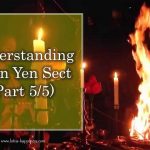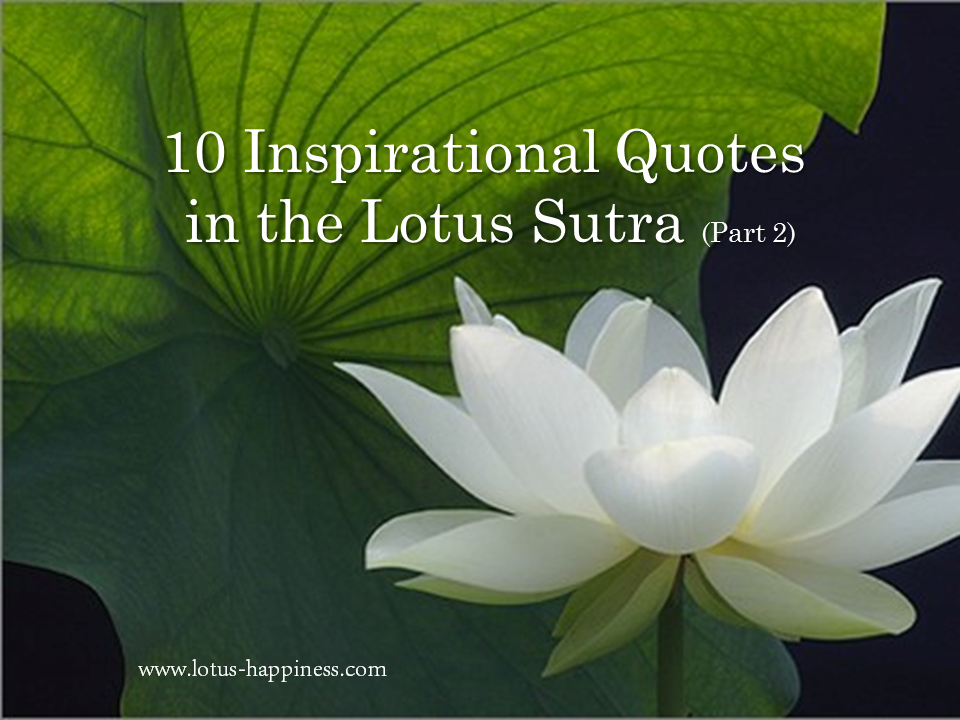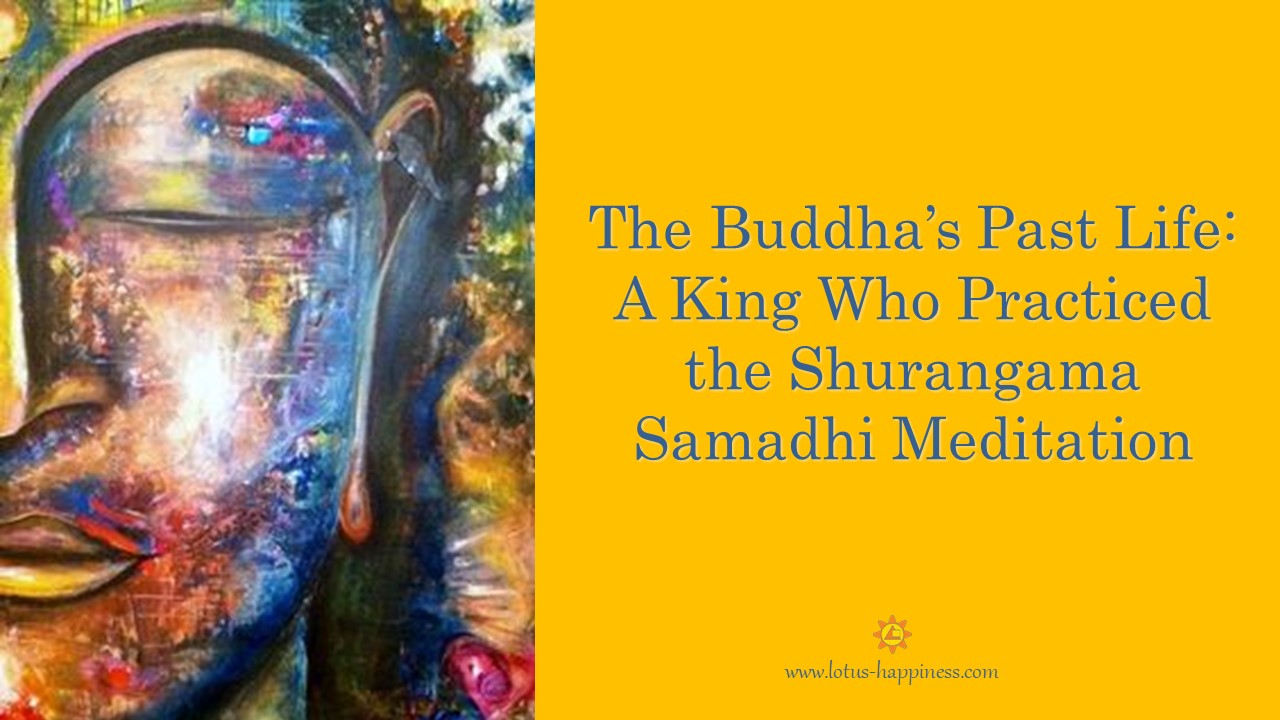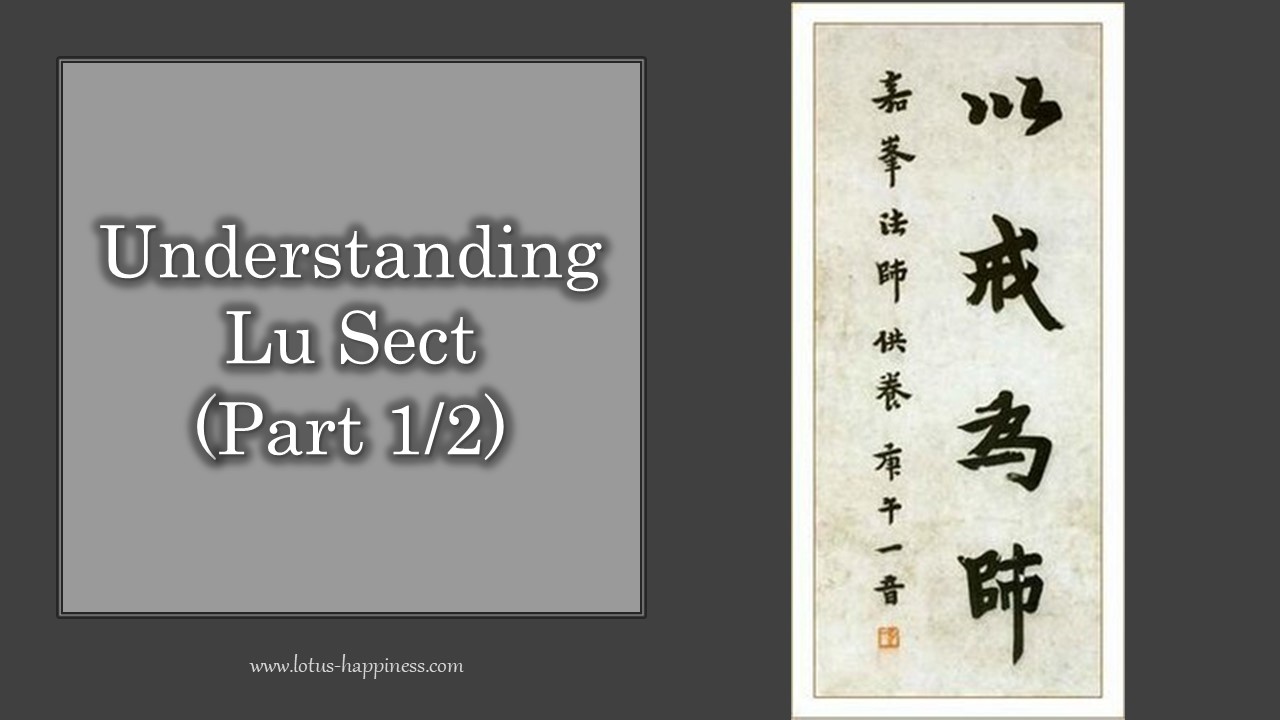Eightfold Path: Insights from the Lotus Sutra

The Eightfold Path is taught in the fourth of the Four Noble Truths – the Truth of a Way to Cease Suffering. The Eightfold Path is an eight-step strategy to help one liberate from the suffering arising from transmigration of life and attain Arhatship.
The Eightfold Path comprises of:
- Right View
- Right Thought
- Right Speech
- Right Action
- Right Livelihood
- Right Effort
- Right Mindfulness
- Right Concentration
With respect to Buddhist symbolism, the Eightfold Path is represented by Dharma Wheel (Dharma Chakra) in which the eight spokes denotes the eight elements of the path.
“…Just this noble eightfold path: right view, right aspiration, right speech, right action, right livelihood, right effort, right mindfulness, right concentration. That is the ancient path, the ancient road, traveled by the Rightly Self-awakened Ones of former times. I followed that path.”
— The Buddha, Nagara Sutta, Samyutta Nikaya ii.124, Translated by Thanissaro Bhikkhu
Relationship between Eightfold Path and Six Paramitas
The Eightfold Path and the Six Paramitas are closely connected. In fact, the elements of the Eightfold Path can be categorised within the framework of Six Paramitas. Here is a picture of their relationship:
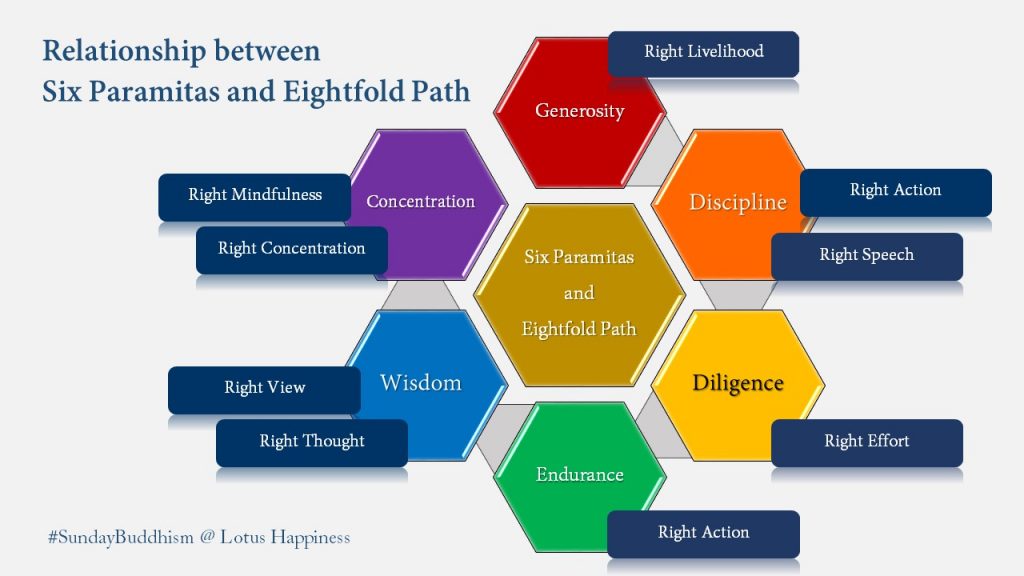
Before I go into explaining each of the eightfold path, the word “right” can be a very subjective word because the meaning of “right” varies according to changes in context, individual, and circumstances. As such, it is important to establish a reference point, which in our case, is the meaning of “right” from the perspective of the Lotus Sutra.
Right View (正见)
Having a Right View is the mark of a person of wisdom. People who have the Right View is able to differentiate between right from wrong, as well as truth from falsehood. Right View can be categorised under “Wisdom” in Six Paramitas.
From the spiritual perspective, Right View means understanding that suffering exists in the Threefold World and that the teaching of Four Noble Truths is capable of eradicating suffering in the conditioned world.
The Buddha expounds the teachings of the Law of Cause and Effect, the Ten Factors, and Twelve-Linked Chains of Causation. All these teachings essentially mean that the Universe arise from the Law of Causation rather than creation by a supreme God as taught by Abrahamic faith. This teaching is relevant for those who do not have the Buddha as the spiritual teacher (eg. Pratyekabuddha, non-Buddhist who believe in creation theory etc)
“.. There is no birth, no emerging, no arising, no name, no form, no substantial existence, no quantity, no boundary, no hindrance, and no obstruction. All phenomena arise by reason of causation; and they are commonly explained in an inverted manner by reason of creation.” (Lotus Sutra 14: 1.8)
From the perspective of the Lotus Sutra, Right View means knowing that the purpose of a Buddha is to guide all living beings toward Buddhahood and that the Lotus Sutra is the seed to attaining Buddhahood. By embracing, learning, and sharing the Lotus Sutra, we are doing the Buddha-work to awaken the Buddhahood in all humanity.
The ultimate truth of Buddhism is simple: Everybody is a Buddha and everyone can walk the path to becoming a Buddha. This is the fundamental Right View of Buddhism as expounded in the Lotus Sutra.
“Now, for you and the rest
I preach the Ultimate Truth—
none of you is shravaka
seeking to attain parinirvana.
All of you are actually pursuing
the way of a bodhisattva.
So long as you gradually learn and practice,
in no time you will all become Buddhas.” (Lotus Sutra 5: 2.41)
Right Thought (正思维)
Right Thought is also known as Right Aspiration. It can be categorised under “Wisdom” in Six Paramitas as well.
Every individual is different in terms of stages of spiritual development. To accommodate the varying cognitive ability of individuals, the Buddha applies the expedient methods to teach flexibly so that everyone is able to receive appropriate teachings relevant to their particular needs.
When his disciples are ready, the Buddha teaches them the Lotus Sutra so as to cultivate their inner Buddhahood for the purpose of attaining Supreme Perfect Enlightenment.
The seed of Buddhahood begins when people conceive of aspiration for Buddhahood. This aspiration is a binding vow that enables a person to successfully achieving the lofty goal of Buddhahood.
After the Buddha finished expounding the Chapter 25: Universal Gateway through Bodhisattva Avalokitesvara (Guan Yin), 84,000 people in the congregation conceived the aspiration of attaining Buddhahood. Here is the quote:
When the Buddha expounded this chapter of Universal Gateway, eighty-four thousand people in the assembly conceived the aspiration of attaining Supreme Perfect Enlightenment. (Lotus Sutra 25: 2.25)
Simply put, Right Thought is the aspiration for Buddhahood.
Right Speech (正语)
Buddhism is spread through dialogues with people. Hence, the importance of speech and communication can never be over-emphasized. The Buddha often praised his disciples who were articulate and well-spoken. Purna is one of the Buddha’s disciples who are foremost in joyful preaching.
As the saying goes, “Words can heal, and words can kill.” In the Ten Evil Acts, four of which are verbal-related: lying, irresponsible speech, defamation, and duplicity. Thus, we need to be mindful of refraining from speaking irresponsibly.
What constitutes Right Speech?
Words of praise to give recognition, words of comfort to give hope, words of affirmation to give encouragement, words of Dharma to give the gift of Buddhahood are all components of Right Speech.
Furthermore, the ability to speak with savoir-faire or tactfulness are also essential. This shows our consideration and kindness toward people around us. Always be mindful not to complain, condemn or criticise others because all these actions are bound to generate ill-will that results in conflicts with others.
“To expound widely the Lotus Sutra for the four groups, these virtuous men and women should enter the sanctuary of Tathagata, put on the robe of Tathagata, and sit on the throne of Tathagata. The ‘sanctuary of Tathagata’ is a mind of great mercy and compassion toward all living beings, the ‘robe of Tathagata’ is a heart of gentleness and patience, and the ‘throne of Tathagata’ is the awareness of the emptiness of all phenomena. Fully embracing and applying the three principles, they are empowered to extensively expound the Lotus Sutra for bodhisattvas and the four groups of people with an unflagging mind.” (Lotus Sutra 10: 2.11)
Right Speech can be arbitrarily categorised under “Discipline/Morality” in Six Paramitas.
Right Action (正业)
Right Action is also known as Right Conduct. Action, known as Karma in Sanskrit, is given great emphasis in Buddhism. Generally, Right Action means keeping the Five Precepts, performing the Ten Virtuous Acts and avoiding the Ten Evil Acts.
Right Action can be categorised under “Discipline/Morality” in Six Paramitas.
The Buddha teaches two types of Law: the Law of Cause and Effect, and the Law of Emptiness.
The Law of Cause and Effect dictates that every action has consequences. Therefore, it is important to be mindful of taking the right actions in different situations.
“O Shariputra! . . . This is because the Law attained by the Buddha is the foremost, exceptionally rare, and difficult to comprehend. Only among Buddhas can the true aspects and characteristics of the ultimate Law be fully grasped. The ultimate Law consists of such an appearance, such a nature, such an entity, such a force, such an action, such a cause, such an environment, such a result, such an effect, and such a coherent consistency from the beginning to the end.” (Lotus Sutra 2: 1.5)
Our conducts and how we carry ourselves go a long way in creating a bright future. Wisdom, experience and tactfulness do play a significant role in influencing the actions we make at every moment. Practising mindfulness is also an action in itself as it helps a person to develop wisdom and cultivate inner peace so that we are better equipped to deal with the many challenges in life.
Apart from the Law of Causality, the Law of Emptiness is frequently taught by the Buddha for the purpose of helping his disciples eradicate negative karma. According to the Sutra of Meditation on Bodhisattva Universal Worthy, meditation upon emptiness is considered a type of repentance that is capable of eliminating all unwholesome karma accumulated in innumerable past lifetimes.
If there are living beings who make obeisance to the Buddhas in the ten directions six times every day and night, recite the Great Vehicle sutra, and ponder upon the profound Law of Emptiness, which is the foremost in meaning and principle, then it only takes the time of a snap of a finger for them to eliminate the sins of birth and death accumulated over hundreds of millions of billions of asamkhya kalpas. (MBUW 9.4)
Right Livelihood (正命)
Right Livelihood means the types of jobs or careers. Certain vocations that involve killing of animals such as fishing and hunting are not advisable. This is because the evil karma of killing will result in unsavoury retribution in next lifetime.
When we work, we are actually creating values for people through the provision of products or services. For instance, in the world of literature, literary works by William Shakespeare, Jane Austen, Walt Whitman and many more have inspired joy for millions of people generation after generation. Their works are actually gifts – an expression of generosity – for posterity.
If you think that work is merely to earn money, think again. Your work means much more than just personal gains, they are the gifts for humanity.
“If there are living beings
who have encountered many former Buddhas,
upon hearing the Law, they practice
generosity, morality, forbearance,
diligence, meditation, or wisdom,
thus cultivating an abundance of blessings and insight;
these people have already
attained Buddhahood. (Lotus Sutra 2: 5.38)
Thus, Right Livelihood can be arbitrarily categorised under “Generosity” in Six Paramitas.
Right Efforts (正精进)
Diligence is the key to success. Without putting in real efforts, there is next to impossible to achieve any endeavours of significance value. So long as we are willing to work hard, victory is around the corner.
Shakyamuni Buddha was diligent in his practice to attain Buddhahood which contributed to his swift attainment of Buddhahood before Ananda does.
Meanwhile, the Bhagavat, having perceived the thoughts of these bodhisattvas, responded: “O virtuous men! When Ananda and I were at the place of King of Emptiness Buddha, both of us conceived the aspiration to attain Supreme Perfect Enlightenment. Ananda was always delighted in the wide knowledge of the Law while I constantly advanced the practice diligently. Therefore, I have already attained Supreme Perfect Enlightenment while Ananda protects and upholds my Law. Similarly, he will protect the Treasury of the Law of many Buddhas in the future, teaching, transforming, and leading multitudes of bodhisattvas. Such was his original vow and hence this is his prophecy.” (Lotus Sutra 9: 2.2)
Right Efforts is like a marathon, slow and steady wins the race. Energy and vitality are pivotal, so make sure we have sufficient rest and sleep to rejuvenate and revitalise ourselves to accomplish tasks and goals every day.
Right Efforts can be categorised under “Diligence” in Six Paramitas.
Right Mindfulness (正念)
Right Mindfulness can be categorised under “Concentration” in Six Paramitas. The Chinese Character of “念” (Nian) consists of two characters “今” (Jin) which mean “Present” and “心” (Xin) which means “Mind”. Combined together, the meaning of “念” (Nian) is concentrating the mind at the present moment.
The mindfulness movement is sweeping the Western world. Many people are interested in learning mindfulness meditation from veteran Buddhist teachers to cultivate wisdom and develop inner peace and happiness. Our minds are like monkeys, never sitting still even for a moment. By focusing on the present moment, we are appreciating the beauty and simple pleasures of our life at that very moment.
From the perspective of the Lotus Sutra, Right Mindfulness means having an awareness of our inner Buddhahood within. When we are mindful that all living beings are essentially Buddhas, our hearts of compassion and loving-kindness radiate and expand. The constant mindfulness of inner Buddhahood is capable of awakening the Buddhahood in others.
“Every day, I am thinking:
‘How can I lead all living beings
to enter the unsurpassed Way
so as to quickly acquire the body of a Buddha?’” (Lotus Sutra 16: 3.23)
Right Concentration (正定)
Right Concentration is the same as the “Concentration” in Six Paramitas. Concentration, also known as Samadhi, means single-pointed focus during meditation. There are 4 stages of dhyana meditation for those who wish to progress in the practice of meditation.
In the Lotus Sutra, there are many bodhisattvas who have practised various types of Samadhi. Bodhisattva Wonderful Music has practised 16 types of Samadhi:
Meanwhile, a bodhisattva named Wonderful Music, who had cultivated many virtuous roots for a long time, also lived in the land of Adorning with Pure Light. He had accomplished the profound wisdom as a result of giving offerings to immeasurable hundreds of thousands of millions of billions of Buddhas. The hundreds of thousands of millions of billions of Ganges’s sands of great samadhis he attained were as follows: the Samadhi of Wonderful Banner Form, the Samadhi of the Law of Lotus, the Samadhi of Pure Virtue, the Samadhi of Sports of King Constellation, the Samadhi of Universal Benevolence, the Samadhi of Wisdom Seal, the Samadhi of Understanding Languages of All Living Beings, the Samadhi of Magnet for All Merits, the Samadhi of Purity, the Samadhi of Divine Sports, the Samadhi of Wisdom Torch, the Samadhi of Majestic King, the Samadhi of Pure Radiant Light, the Samadhi of Pure Treasury, the Samadhi of Individuality, and the Samadhi of Sun’s Revolution. (Lotus Sutra 24: 1.3)
Another meaning for Right Concentration is “Single-Mindedness” (一心). In the Lotus Sutra, the Buddha repeatedly urge his disciples to single-mindedly practice and propagate the Lotus Sutra for the benefit of all living beings.
“You should single-mindedly
propagate the Lotus Sutra far and wide.
Then, you will encounter Buddhas
lifetime after lifetime,
to quickly accomplish the Buddha-Way.” (Lotus Sutra 20: 2.15)
In essence, I have revealed and expounded all the teachings of Tathagata, all the effortless divine powers of Tathagata, all the Secret Treasuries of Tathagata, and all the profound historical events of Tathagata in the Lotus Sutra. Therefore, after the parinirvana of Tathagata, all of you shall single-mindedly practice the Law by accepting, embracing, reading, reciting, explaining, preaching, copying, and transcribing the Lotus Sutra. (Lotus Sutra 21: 1.8)
Summary
The Eightfold Path is taught in the fourth of the Four Noble Truths – the Truth of a Way to Cease Suffering. The Eightfold Path comprises of Right View, Right Thought, Right Speech, Right Action, Right Livelihood, Right Effort, Right Mindfulness, Right Concentration.

Let’s Connect Now
Follow us by Liking our Facebook
Subscribe our Newsletter
Support Lotus Happiness
Do support Lotus Happiness in the Dharma propagation by purchasing a copy of the Lotus Sutra in the Amazon.


